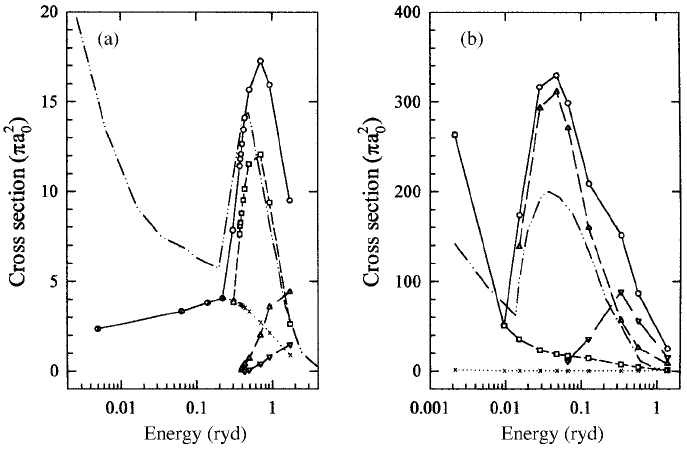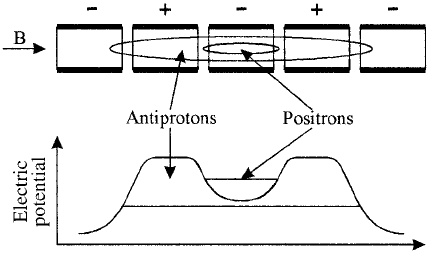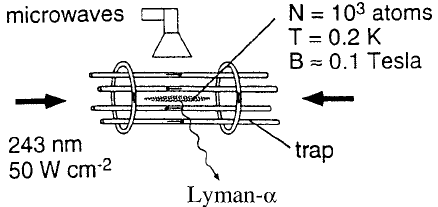Charlton M., Humberston J.W. Positron Physics
Подождите немного. Документ загружается.


8.3 Antihydrogen 379
As outlined by Wolf (1993) and Holzscheiter et al. (1996), similar con-
siderations to those described above also apply to recombination in traps,
and in particular the nested Penning-trap scheme (see below), again with
appropriate assumptions regarding the speed distributions of the trapped
positrons and antiprotons and their degree of spatial overlap. As an
example, Holzscheiter et al. (1996) argued that the recombination rates
are of the order of one per second (though dependent upon E
e
) for 10
6
positrons and 10
5
antiprotons trapped in a volume of 1 cm
3
.
Use of the charge-exchange mechanism, reaction (8.13), to produce
antihydrogen was first proposed by Deutch et al. (1986), and subsequently
it was shown that the cross section for this process could be obtained by
applying the charge conjugation and time reversal operators to the process
of positronium formation in positron–hydrogen collisions (Humberston
et al., 1987, and see section 4.2). Under time reversal, the positronium
formation process equation (4.5) becomes
Ps+p→ H+e
+
, (8.22)
with a cross section σ
H
. The further application of charge conjugation
then yields reaction (8.13), for which the cross section is also σ
H
, assum-
ing charge conjugation invariance. Time reversal invariance implies the
symmetry of the S-matrix, from which the relationship between σ
H
and
σ
Ps
can be derived. Consider a positron colliding with a hydrogen atom, in
a state with principal and orbital angular momentum quantum numbers
n
H
and l
H
respectively, and producing positronium with corresponding
quantum numbers n
Ps
and l
Ps
. If the cross section for this process is
σ
Ps
(n
Ps
,l
Ps
; n
H
,l
H
), then the cross section for the time-reversed process is
σ
H
(n
H
,l
H
; n
Ps
,l
Ps
), and
σ
¯
H
(n
¯
H
,l
¯
H
; n
Ps
,l
Ps
)=σ
H
(n
H
,l
H
; n
Ps
,l
Ps
)
=
k
2
(2l
H
+1)
κ
2
(2l
Ps
+1)
σ
Ps
(n
Ps
,l
Ps
; n
H
,l
H
), (8.23)
where k and κ are the wave numbers of the positron and positronium
respectively. Energy conservation gives the relationship between them as
E =
k
2
2
−
1
2n
2
H
=
κ
2
4
−
1
4n
2
Ps
. (8.24)
If the initial positronium and the residual antihydrogen are both in the
ground state (n
¯
H
= 1 and n
Ps
= 1) the relationship between the cross
sections reduces to
σ
¯
H
= σ
H
=
k
2
κ
2
σ
Ps
. (8.25)
380 8 Exotic species involving positrons
The simple conversion factor k
2
/κ
2
was applied by Humberston et al.
(1987) to the positronium formation cross sections of Brown and Humber-
ston (1984) within the Ore gap, the distorted-wave Born approximation
results of Shakeshaft and Wadehra (1980) from the top of the Ore gap to
200 eV, and the Born results of Omidvar (unpublished) beyond 200 eV,
to yield the first estimates of the antihydrogen formation cross section.
These results relate only to the formation of ground state antihydrogen
in collisions of antiprotons with ground state positronium, but Darewych
(1987) and Nahar and Wadehra (1988), using the first Born approxima-
tion, calculated the cross sections for the formation of antihydrogen in
various excited states with n
¯
H
≤ 3. The latter authors also attempted
to include contributions to the total formation cross section from antihy-
drogen states with n
¯
H
> 3: they exploited the fact that, at sufficiently
high energies, the Born approximation predicts the cross section for the
formation of antihydrogen in a state with principal quantum number n
¯
H
to be σ
¯
H
(n
¯
H
) ∝ 1/n
3
¯
H
. However, this scaling law is almost certainly not
valid at the low energies of greatest experimental interest here. Nahar
and Wadehra (1988) also used the Born approximation to calculate the
cross sections for ground state antihydrogen formation in collisions of
antiprotons with positronium in the n
Ps
= 2 state. They then used the
above form of scaling law to estimate the contributions to the total ground
state antihydrogen formation cross section from antiproton collisions with
positronium in higher excited states.
All these contributions add up to a total antihydrogen formation cross
section of approximately 2 × 10
−15
cm
2
in the antiproton energy range
2–10 keV where the charge-exchange production mechanism is likely to be
most effective. This value is consistent with results obtained by Ermolaev,
Bransden and Mandal (1987), who used the classical trajectory Monte
Carlo method, and also with the results of a recent experiment (Merrison
et al., 1997) which measured the hydrogen atom formation cross section
via reaction (8.22).
Further investigations have been made of antihydrogen formation in
collisions of protons with excited state positronium. Igarashi, Toshima
and Shirai (1994), using a hyperspherical coupled-channel method, found
that at an energy of approximately 0.04 ryd the formation cross sections
for antiprotons in collision with positronium in the 2S and 2P states were
each approximately 300πa
2
0
, more than ten times the magnitude of the
formation cross section from ground state positronium. They surmised
that the formation cross sections would be even larger for positronium in
higher excited states. Mitroy and Stelbovics (1994), using the unitarized
Born approximation, obtained results that were qualitatively similar but
rather smaller in magnitude.

8.3 Antihydrogen 381
Fig. 8.10. Cross sections for antihydrogen formation in collisions of stationary
antiprotons with positronium atoms (from Igarashi, Toshima and Shirai, 1994).
(a) is for 1S positronium and (b) is for the 2P state (note the changes in scale).
Key (same for both figures): dotted curve with crosses, formation into the n
¯
H
=1
state; short-broken line plus squares, formation into the n
¯
H
= 2 state; long-broken
line plus triangles, formation into the n
¯
H
= 3 state; very-long-broken line plus
inverted triangles, formation into the n
¯
H
= 4 states. The solid curve with circles
is the total cross section summed over all n
¯
H
states and the double chain curve
is this quantity as calculated by Mitroy and Stelbovics (1994).
The possibility that total antihydrogen production (i.e. integrated over
all states) might be markedly enhanced by antiproton collisions with
excited state positronium was first suggested by Charlton (1990), who
argued from a classical standpoint that σ
¯
H
should increase as the area
of the positronium atom, giving an n
4
Ps
scaling. He also argued that as
n
Ps
was increased, the relative speed at which the cross section would
be a maximum would fall as n
−1
Ps
. The justification for this assump-
tion was based on the Massey criterion, which states that the capture
probability is highest when the speed of the projectile is matched to the
quasi-classical orbital speed of the positron in the positronium. Both these
features are demonstrated qualitatively by the theoretical results shown
in Figure 8.10. Mitroy (1995) investigated antihydrogen formation from
positronium states up to n
Ps
= 4, using the coupled-state method, and
found that the scaling for σ
¯
H
is actually closer to n
3
Ps
than to the fourth

382 8 Exotic species involving positrons
power suggested above. Other work of relevance to this topic has been per-
formed by Mitroy and Ratnavelu (1995) and Mitroy and Ryzhikh (1997).
An interesting method of realizing excited state positronium–antiproton
collisions has been suggested by Hessels, Homan and Cavagnero (1998).
It is clear from the above discussion that the antiproton–positronium
reaction can be a useful means of producing antihydrogen in low-lying
atomic states over a wide range of kinetic energies. Deutch et al. (1988)
suggested a possible method for antihydrogen production via reaction
(8.13), using antiprotons stored in a circular radio-frequency quadrupole
trap. However, given the advances in trapping, cooling and holding
antiprotons in Penning traps described above, it is natural to consider the
feasibility of experiments using such a device.
It is possible to imagine
producing positronium in a Penning trap using a target material such as
SiO
2
(see subsection 1.5.3), which has been shown to emit positronium in
a cryogenic environment (Mills et al., 1989a). Here, the crucial parameters
are the distance of the antiprotons from the shaped electrode housing the
positronium converter and the kinetic energy of the positronium (which
does not have to correspond to the same temp
erature as that of the
target). At present only conceptual designs of such an arrangement exist
(Deutch et al., 1993; Surko, Greaves and Charlton 1997).
Deutch et al. (1993) also noted that the effective recoil temperature, T
¯
H
,
of the antihydrogen is given from conservation of energy and momentum,
ignoring the initial energies of the two reactants, as
T
¯
H
=
2∆Em
3kM
=28.6
2
n
2
¯
H
−
1
n
2
Ps
(K), (8.26)
where m and M are the positron and antiproton masses respectively and
∆E is the difference between the binding energies of the antihydrogen
and positronium states, governed predominantly by n
¯
H
and n
Ps
. The
most favourable condition for capture, so-called resonant charge transfer,
occurs (formally) when ∆E =0(n
¯
H
=
√
2n
Ps
) and thus has T
¯
H
=0. As
an extension to the analysis of Deutch et al. (1993) and in an effort to
simulate a real experimental situation, Cassidy et al. (1999) performed a
Monte Carlo simulation of the antiproton–positronium reaction. This was
done by making assumptions concerning the temperature distribution of
the trapped antiprotons and the energy distribution of the positronium
atoms, taken to be that typically resulting from positron impact on a sur-
face; they used as input the cross sections, differential and total, of Mitroy
and Ryzhikh (1997) and Mitroy (1997, private communication) for the
antiproton–positronium reaction. This analysis found the antihydrogen
formation rate in the ground state to be rather low, of the order of 100
per hour for 10
7
trapped antiprotons and with a positron flux of 3 × 10
7
s
−1
. (These figures are close to the maximum which can presently be

8.3 Antihydrogen 383
expected from a laboratory-based positron beam and for antiprotons held
in a Penning trap.) Of these anti-atoms, only approximately 1% had a
temperature below 1 K, which is around the maximum well depth that can
be achieved using magnetic-gradient traps (see e.g. Hess et al., 1987, and
Gomer et al., 1997, for discussions of this type of device) with currently
available technology. Further discussion of the details of antihydrogen
formation by the antiproton–positronium reaction have been given by
Charlton (1996, 1997).
We now turn to reaction (8.14), the trapped plasmas combination
reaction, in which the excess energy is removed by an extra positron
as shown in Figure 8.9(c). The use of this ternary reaction for anti-
hydrogen formation was first suggested by Gabrielse et al. (1988), who
noted that its matter equivalent had been studied, mainly in relation to
high temperature plasmas, for some time. These authors were therefore
able to write the antihydrogen production rate, which corresponds to the
recombination rate in conventional plasma physics, as
R
¯
H
=6× 10
−12
4.2
T
9/2
n
2
e
+
. (8.27)
This formula for the rate per trapped antiproton
is notable for its very
strong positron-temperature dependence, T
−9/2
(in degrees K), and the
presence of the positron density, n
e
+
(in cm
−3
), to the second power. The
latter dependence arises because two positrons are needed in the reaction.
In their analysis, Gabrielse et al. (1988) assumed that a plasma of 10
7
positrons per cm
3
would be produced at 4.2 K, which yielded R
¯
H
∼ 600
s
−1
per trapped antiproton. Glinsky and O’Neil (1991) re-examined this
problem from a plasma physics viewpoint, and found that the combination
rate given by equation (8.27), which is actually that pertaining to zero
field, B = 0, is reduced by an order of magnitude in a highly magnetized
plasma (B ≈∞). In essence, this is caused by the constraint imposed on
the positron orbits, since they cannot cross the magnetic field lines.
In order to promote reaction (8.14) it is necessary to trap both antipro-
tons and positrons and merge the two swarms. A schematic illustration
of a sequence of traps to achieve this, the so-called nested Penning trap
arrangement (Gabrielse et al., 1988), is shown in Figure 8.11. Again the
radial confinement of the two clouds is provided by large axial magnetic
fields with appropriate voltage elements that produce potential wells to
trap the opposite charges. The positron well is nested within empty
wells into which the antiprotons can be moved, and the basic idea is to
adjust the depth of the wells so that the antiprotons just pass through the
positron cloud. The nested-trap scheme was developed further by Quint
et al. (1993), who reported the results of preliminary measurements on

384 8 Exotic species involving positrons
Fig. 8.11. Illustration of the principle of nested Penning traps for holding
antiprotons and positrons in close proximity, in order to promote antihydrogen
formation.
merged, trapped swarms of protons and electrons. Hall and Gabrielse
(1996) demonstrated the electron cooling of trapped protons using a
nested-well apparatus. Haarsma, Abdullah and Gabrielse (1995) reported
progress in accumulating positrons under ultra-high vacuum conditions
typical of those in antiproton traps in quantities sufficient to promote
reaction (8.14). Experiments carried out at CERN by Gabrielse and
coworkers (reported by Gabrielse et al., 1999) during the last days of
the operation of LEAR managed to confine antiprotons and positrons
together in a multi-electrode apparatus for the first time, though the
effects observed when the clouds were merged could not be attributed to
antihydrogen formation.
One of the potential drawbacks of reaction (8.14) is that the antihy-
drogen will initially be produced in a Rydberg state with a high value
of n
¯
H
, since the energy removed by the extra positron is of the order
of k
B
T . This has been confirmed by the analysis of Pajek and Schuch
(1997), who studied the time-reversed process (impact ionization) to de-
rive a recombination coefficient for reaction (8.14). Their numerical values
are in accord with equation (8.27), but they found that the coefficient
was proportional to n
6
¯
H
, thus dramatically favouring initial capture into
high-lying Ryberg states. Such atoms have long radiative lifetimes, and
Glinsky and O’Niel (1991) and Fedichev (1997) have pointed out mecha-
nisms which can lead to collisional stabilization. These involve so-called
replacement collisions at higher values of n
¯
H
, whereby once the atom
has been formed, another positron travelling on a path closer to the
antiproton takes the place of the first positron, which leaves, carrying
the excess energy. At lower values of n
¯
H
this process becomes ineffi-
cient at the plasma densities envisaged, but another process, transverse
collisional drift, occurs. Here the bound positron drifts across the field
8.3 Antihydrogen 385
lines towards the antiproton under the influence of distant positron–atom
collisions.
Both of these analyses rely on the fact that, to produce stable antihy-
drogen, the relaxation processes must occur before the atom leaves the
plasma, otherwise it will be field ionized. Alternatively, as discussed by
Wolf (1993), it may be possible to laser-stimulate transitions to more
tightly bound levels to avoid the field-ionization problem.
We now consider the final method listed above for antihydrogen pro-
duction. Reactions (8.15) were first suggested by Yamazaki (1992), with
further details provided by Ito, Widmann and Yamazaki (1993). The
method is based upon the discovery of Iwasaki et al. (1991) that up to 3%
of antiprotons stopping in helium gas can form a metastable antiprotonic
helium atom (αe¯p) with a lifetime of the order of 3 µs. The basic idea that
such an effect could occur was proposed by Condo (1964). The antiproton,
on stopping in the medium before annihilation, forms this exotic atom
when its kinetic energy falls below the binding energy of the electrons
in the helium (around 25 eV). The captured antiproton then falls
into a
state with principal quantum number, n
o
, close to (M
∗
/m)
1/2
, where M
∗
is the reduced mass of the antiproton–nucleus system. In this case n
o
≈
38, and the energy level spacing is ≈ 2 eV. If the antiproton is captured
into a state with large orbital angular momentum, the transition to the
lower levels will most likely occur through a series of radiative transitions,
with a concomitantly long period (hence the appellation ‘metastable’)
before annihilation. The atomic nature of these states was confirmed
by Morita et al. (1994) in a study involving a laser-induced resonant
transition between two of them. Further discussion of the αe¯p ‘atomcule’
has been given by Kartavstev (1996) and Eades and Hartmann (1999).
The proposed scenario for antihydrogen production involves stopping
a bunch of approximately 10
9
antiprotons in dense helium; this is fol-
lowed shortly afterwards by the injection of a bunch of approximately
10
8
positrons into the same medium. A detailed discussion was given
by Ito et al. (1993); this included a treatment of the differences between
the positrons and the positronium atoms which result from the positron
injection, in terms of the known behaviour of these species in helium
gas; see Chapters 6 and 7. Under optimum conditions, the number of
antihydrogen atoms formed could be as great as 10
3
–10
4
per antiproton
bunch.
Ito, Widmann and Yamazaki (1993) also addressed the problem of the
detection of antihydrogen under these conditions. They estimated that
most of the antihydrogen will be formed tens of nanoseconds after the
positron injection into the 37 atmospheres of helium gas, envisaged as
the stopping medium, and will probably be destroyed within 1 ns after
formation. Thus the antihydrogen signature will be a small spike on the

386 8 Exotic species involving positrons
Fig. 8.12. A possible scenario for trapped antihydrogen spectroscopy. The
microwa
ves quench the 2S
1/2
antihydrogen via the 2P
3/2
state, which sponta-
neously decays by emission of a Lyman-α photon.
αe¯p atomcule annihilation spectrum, at a time governed mainly by the
time difference between the injection of the positrons and the antiprotons
and the diffusion coefficients of the lighter species. Ito, Widmann and
Yamazaki (1993) noted that such an observation would, strictly speaking,
indicate only that some of the antiprotons had annihilated more rapidly
with the positrons present and not necessarily that antihydrogen had
been formed. To prove the latter they envisaged using lasers to ionize
the antihydrogen and to observe the associated antiproton annihilation.
For this purpose they asserted that the antihydrogen has to survive for
around 10 ns in the gas, which suggests that the pressure will have to be
lower than the value assumed above.
It should be noted that even if antihydrogen were to be formed by
this technique, the prospects for precision studies of the kind outlined
in subsection 8.3.1, which might offer a challenge to some of the basic
postulates of physics, are not likely to be easy.
4 Prospects for antihydrogen physics
Advances in trapping and cooling antiprotons make it likely that antihy-
drogen will soon be produced with kinetic energies suitable for trapping
and also, possibly, in beams. Almost all the production scenarios outlined
above rely on using a source of low energy antiprotons, such as LEAR
and associated machinery and, although the former unique facility closed
at the end of 1996, continuation of a low energy antiproton programme
at CERN in 1999 and beyond has been assured by the approval of the
Antiproton Decelerator project (Maury, 1997).
A possible glimpse of the future is provided by Figure 8.12, which
shows a schematic illustration of a magnetic-gradient trap for anti-atom
spectroscopy. The scenario described below is due to H¨ansch and Zimmer-
8.3 Antihydrogen 387
mann (1993), who assumed that a sample of 10
3
antihydrogen atoms could
be held in such a trap at a temperature of 0.2 K. A uniform magnetic field
of around 0.1 T (for antiproton and positron confinement) is superimposed
upon the field produced by the quadrupole coils, which ensures that a local
field minimum exists in the trap centre. Such a field configuration is well
known to produce a shallow trap for neutral species with an appropriate
magnetic moment. The schematic shows the anti-atoms, initially in the
1S state, raised into the 2S state by a Doppler-free two photon (243 nm)
transition and further pumped by microwaves into the 2P state, which
then decays back to the ground state with the emission of a Lyman-α
photon. This resonance fluorescence is used as the signature of the tran-
sition. H¨ansch and Zimmermann (1993) also described how this cycle
can be operated on trapped anti-atoms to prevent spin flips and keep
them stored for longer periods. Holzscheiter and Charlton (1999) have
described an alternative scheme of observing the 1S–2S transition which
does not rely on the detection of the Lyman-α photon.
As described briefly in subsection 8.3.1, the ultimate goal for a hydrogen–
antihydrogen comparison for this transition is a fractional frequency
difference in the region of 10
−18
and as such would provide a stringent test
of CPT invariance and of the WEP. The achievement of such precision
is, however, a distant goal, most probably to be realized through a long
series of steps, with much development work still to be done with ordinary
matter reactions.
